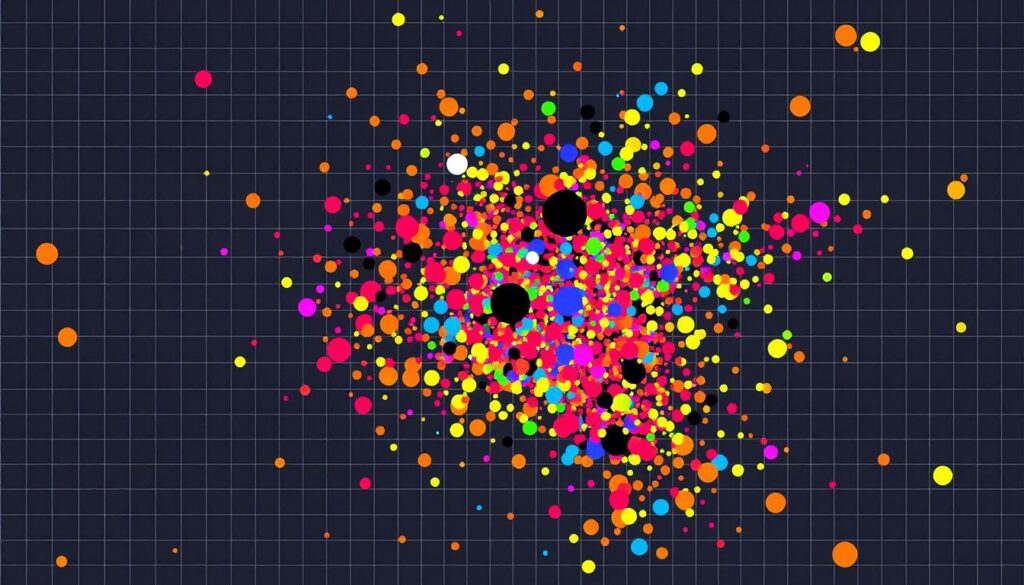In the world of data analysis, are key to finding hidden insights in big datasets. They use and to find and . This helps make better decisions in many fields1.
At the core of this tech is . It groups similar data points, showing the data’s natural structure. This helps companies understand their data better, create personalized experiences, and handle the data-driven world2.
Key Takeaways
- Clustering algorithms are a powerful tool for and .
- These algorithms can uncover hidden and within complex datasets.
- Clustering techniques like K-Means, Hierarchical Clustering, and DBSCAN are widely used in various industries.
- Clustering algorithms have diverse applications, including customer segmentation, image processing, and anomaly detection.
- Evaluating the performance of clustering algorithms is crucial for ensuring optimal results.
Introduction to Clustering
Clustering is a key method in unsupervised learning, used in data mining and exploration. It groups data into clusters, where points in the same cluster are more alike than those in others3. This helps find patterns and relationships, leading to valuable insights and better decision-making.
What is Clustering?
Clustering groups data points based on their similarities, without labels4. It uncovers hidden structures and patterns, making it essential for data analysis.
Types of Clustering Algorithms
There are many clustering algorithms, each with its own benefits and drawbacks. Here are some common ones:
- Partitioning Clustering: K-Means and K-Medoids divide data into a set number of clusters.
- Hierarchical Clustering: Builds a hierarchy of clusters, showing data at various levels.
- Density-Based Clustering: DBSCAN finds clusters based on data density, handling noise well.
- Distribution-Based Clustering: Gaussian Mixture Models model data as a mix of distributions.
The right algorithm depends on the data’s nature, the goals, and the challenges it presents34.

“Clustering is a powerful tool for uncovering hidden patterns and insights within data, transforming the way we approach data analysis and decision-making.”
K-Means Clustering
K-means clustering is a key method in machine learning5. It groups data into distinct clusters, with each point belonging to only one5. The algorithm works by finding the closest cluster for each data point, aiming to group similar data together6.
How the K-Means Algorithm Works
The algorithm begins with initial cluster centers. It then assigns each data point to the nearest cluster6. The centers are updated to the mean of the assigned points, and this process repeats until no more changes are needed6.
Improving the k-means algorithm is key to getting the best results5. The k-means++ method helps in choosing better initial centers for better clustering5.
Applications of K-Means
K-means is used in many areas, like market segmentation and image compression5. It’s great for data that’s clearly separated7. It’s also used in industries for tasks like customer segmentation5.
To check how well the clusters are formed, metrics like inertia and the Dunn index are used5. The elbow method helps find the right number of clusters visually5.

“K-means clustering is a powerful tool for unsupervised machine learning, allowing us to uncover hidden patterns and structures in data by grouping similar data points together.”
In summary, k-means clustering is a crucial tool in data science and machine learning. Knowing how it works and its uses can help us uncover valuable insights from our data576.
Clustering Algorithms
There are more than just K-Means for clustering data. Hierarchical Clustering and DBSCAN (Density-Based Spatial Clustering of Applications with Noise)8 are two notable methods. They each bring their own strengths to the table.
Hierarchical Clustering
Hierarchical clustering creates a tree-like structure of clusters. It can merge smaller ones into bigger ones or split larger ones into smaller ones. This method is great for showing how clusters are related through a dendrogram8.
It’s especially useful for data that has a natural hierarchy, like taxonomies. You can pick how many clusters you want by cutting the dendrogram9.
DBSCAN (Density-Based Spatial Clustering of Applications with Noise)
DBSCAN groups data points based on how dense they are. It doesn’t need you to decide how many clusters there should be. This makes it good for finding clusters of any shape and dealing with noisy data8.
Unlike K-Means, DBSCAN is more flexible. It works well with complex data structures without needing to guess the number of clusters10.
| Clustering Algorithm | Characteristics | Advantages | Limitations |
|---|---|---|---|
| Hierarchical Clustering | – Builds a hierarchy of clusters – Agglomerative (merging) or divisive (splitting) approach – Visualized using dendrograms | – Suitable for hierarchical data (e.g., taxonomies) – Allows selecting the desired number of clusters by cutting the dendrogram | – Computationally expensive for large datasets – May struggle with clusters of varying densities |
| DBSCAN | – Density-based clustering – Groups data points based on density – Can identify arbitrary-shaped clusters and noise points | – Does not require pre-defining the number of clusters – Handles outliers and noise effectively | – Less effective with clusters of varying densities – Performance may degrade in high-dimensional spaces |
Hierarchical clustering and DBSCAN are great for different tasks. They complement K-Means well8109.
Advanced Clustering Techniques
Clustering algorithms like K-Means and DBSCAN are common, but there are more advanced methods. These include Gaussian Mixture Models (GMMs) and Spectral Clustering. They help find deeper insights in complex data11.
Gaussian Mixture Models
Gaussian Mixture Models (GMMs) model data as a mix of Gaussian distributions11. This gives a detailed look at the data. GMMs are great for finding complex clusters and work with different data types11.
Choosing the right number of clusters is key. Criteria like Bayesian Information Criterion (BIC) and Integrated Completed Likelihood (ICL) help with this11.
Spectral Clustering
Spectral Clustering uses eigenvalues and eigenvectors to find clusters11. It’s good at finding complex clusters and the data’s structure11. It’s also great for high-dimensional data.
Both GMMs and Spectral Clustering are advanced techniques for complex data11. They use complex math to uncover hidden patterns. This helps researchers understand their data better and make informed decisions.
| Clustering Technique | Key Characteristics | Applications |
|---|---|---|
| Gaussian Mixture Models (GMMs) | Probabilistic approach to clustering Models data as a mixture of Gaussian distributions Assigns probabilities to data points belonging to clusters Effective for complex, non-convex clusters Accommodates various data types and distributions | Customer segmentation Anomaly detection Bioinformatics Image processing |
| Spectral Clustering | Utilizes eigenvalues and eigenvectors of similarity matrix Effective for discovering complex-shaped, non-convex clusters Captures underlying manifold structure of data Useful for high-dimensional data | Social network analysis Image segmentation Recommendation systems Bioinformatics |
Exploring these advanced techniques can lead to deeper insights11. They are powerful tools for data analysis. They help handle complex data structures, making them essential in the field.
Evaluating Clustering Results
Checking how good clustering results are is key to understanding them well. Metrics like the silhouette score and the Davies-Bouldin index help a lot. They show how well clusters stick together and how different they are from each other12. The elbow method also helps find the best number of clusters by looking at how close data points are within each group12.
Using these methods is important for exploratory data analysis. They help make the clustering better. By looking at different scores, like the Calinski-Harabasz Index and the Rand Index, we get a clearer picture of how good the clusters are1213. Pictures like scatter plots or density plots can also help see the whole picture of the clusters13.
Choosing the right metrics depends on what you want to achieve with clustering. Knowing a lot about the subject helps understand the scores better12. By mixing numbers and pictures, experts can make their clustering work better and more reliable.
“Effective cluster evaluation is essential for identifying the optimal number of clusters and assessing the quality of the clustering solution.”
Conclusion
In this article, we explored the exciting world of clustering algorithms. They show us hidden patterns and connections in complex data14. There are over 100 clustering algorithms, giving data analysts many tools to find data structure14.
We looked at K-Means, Hierarchical Clustering, and DBSCAN. These tools use different methods to analyze data141516. Knowing their strengths and weaknesses helps professionals in many fields. They can use clustering to find important insights and make better decisions.
Clustering algorithms are used in many areas now, like in recommendation systems and market research1416. They also help in social network analysis and finding unusual data points14. Using clustering with supervised machine learning makes these models even better at predicting outcomes14.
FAQ
What is clustering?
Clustering is a machine learning method. It groups similar data points together. This helps find hidden patterns and relationships in data without labels.
What are the different types of clustering algorithms?
There are several clustering algorithms. These include K-Means, hierarchical clustering, DBSCAN, and Gaussian Mixture Models. Each has its own way of grouping data.
How does the K-Means algorithm work?
K-Means is a popular algorithm. It divides data into K clusters. It does this by assigning each data point to the closest cluster and updating the cluster centers to reduce distances.
What are the applications of K-Means clustering?
K-Means is used in many areas. It helps in market segmentation, image compression, and document clustering. It’s also used in network security and genome research for personalized medicine.
How does hierarchical clustering work?
Hierarchical clustering creates a tree-like structure of clusters. It can merge or split clusters. The results are shown in a dendrogram.
What is DBSCAN clustering?
DBSCAN groups data points based on density. It finds clusters of any shape and identifies noise points. It’s a density-based algorithm.
What are Gaussian Mixture Models?
Gaussian Mixture Models treat data as a mix of Gaussians. They assign each data point to a cluster based on probability.
How does spectral clustering work?
Spectral clustering uses eigenvalues and eigenvectors. It’s good at finding complex and non-convex clusters. It’s based on the data’s similarity matrix.
How can we evaluate the quality of clustering results?
To check clustering quality, use the silhouette score and Davies-Bouldin index. They measure cluster cohesion and separation. The elbow method helps find the best number of clusters.
Source Links
- Clustering: Unveiling Patterns and Relationships in Unlabeled Data
- K-Means Clustering – How to Unveil Hidden Patterns in Your Data
- Introduction to Clustering Algorithms
- Introduction to Clustering
- What is k-means clustering? | IBM
- K-Means Clustering- Introduction
- K means Clustering – Introduction – GeeksforGeeks
- Clustering in Machine Learning – GeeksforGeeks
- Clustering algorithms | Machine Learning | Google for Developers
- Cluster analysis
- Advanced Clustering Techniques: A Review and Practical Implementation in Python
- Evaluating Clustering Algorithms: A Comprehensive Guide to Metrics
- Quick Guide to Evaluation Metrics for Supervised and Unsupervised Machine Learning
- Clustering | Different Methods, and Applications (Updated 2024)
- Guide to Clustering Algorithms: Strengths, Weaknesses, and Evaluation
- A Guide to Clustering Algorithms

